THE WICKER MAN (1973)
A puritan policeman arrives in a Scottish island village in search of a missing girl, who the Pagan locals claim never existed.
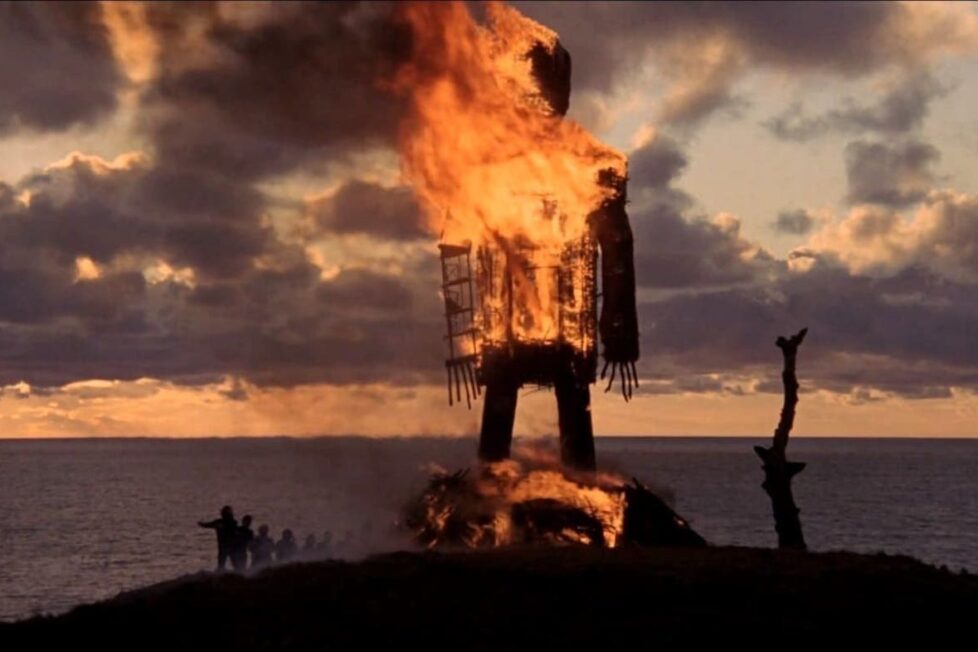
A puritan policeman arrives in a Scottish island village in search of a missing girl, who the Pagan locals claim never existed.


The great works of horror cinema are often identifiable by single images. Whether this is fair to the films, or a reductive way of viewing a piece of art, it’s a practice hard to avoid. The Shining (1980) could be referred to as the film with the blood elevators, while The Exorcist (1973) is the one with the girl whose head twists backwards. To audiences at large, these moments are defining and emblematic of what the films are. In the case of British horror, it could be said that one image defines its entire history: the burning of a Wicker Man.
To call this image iconic or important is true, but reductive. It fails to capture all the nuance and genius contained in The Wicker Man, a film celebrating its 50th anniversary. To revisit the film is to be reminded there’s nothing else like it in horror cinema. To be seduced by its serpentine charms is to tumble down a rabbit hole. The brilliance of The Wicker Man means that no matter what number viewing this might be for you, and no matter whether you know what’s at the end of the rabbit hole, you still find yourself taking the tumble.
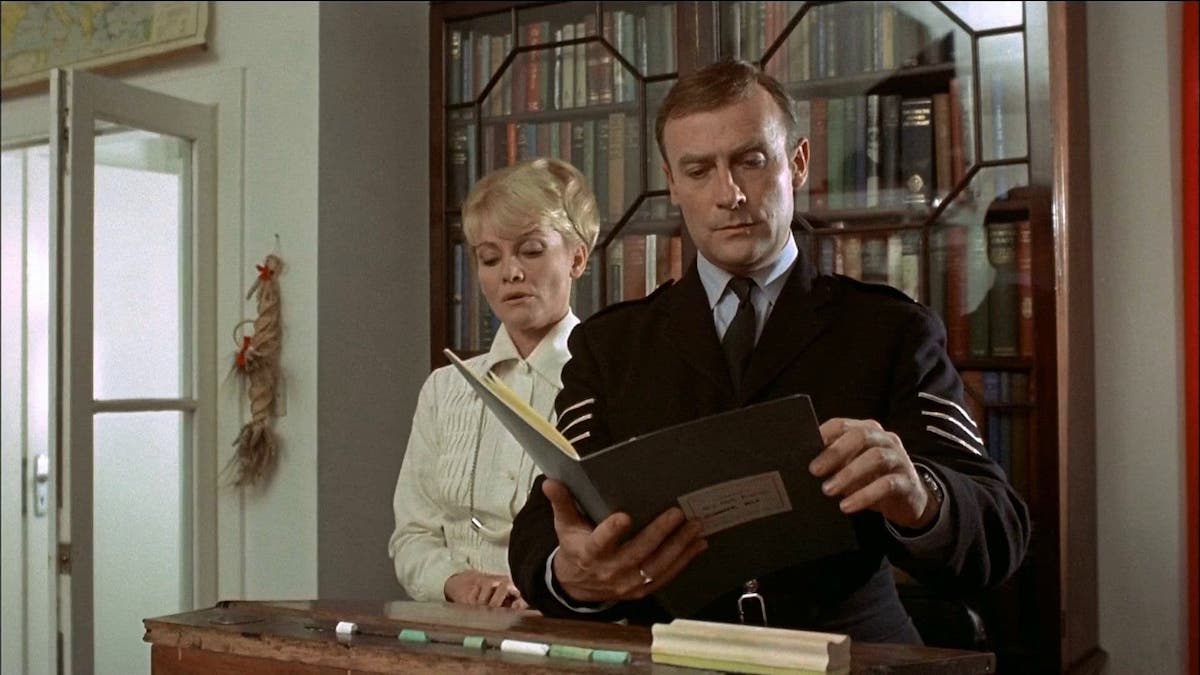
The Wicker Man springs from a deeply ingrained conservative British fear of the ‘Other’. As an island nation, Britain has worked through its fears of invasion and displacement through centuries of art, which naturally went on to include horror films. While Hammer’s horror films channelled the UK’s historical anxieties through lavish period pieces and far-fetched creatures of the night, The Wicker Man eschewed the supernatural and replaced it with an earthly terror. By placing the horror squarely within our isles and in a contemporary setting, The Wicker Man suggests it’s ourselves we’re at war with. The call truly is coming from inside the house.
What it reveals is a nation of paranoiacs, of citizens who make it their moral imperative to be distrustful of other cultures. The Wicker Man feels particularly incendiary in the joy it seems to take in putting these conservative notions through the wringer. This is a horror that dances in the cinders of an old way of thinking and dares to suggest that, deep inside, we’d like to burn it all down too.
Who could be more emblematic of traditional, god-fearing Britain than stern copper Neil Howie (Edward Woodward)? He’s centuries of British repression packaged as a man of the law, his beliefs holding him upright even as they threaten to topple him entirely. He travels by seaplane to Summerisle, a remote Scottish Island from which a teenage girl named Rowan Morrison (Geraldine Cowper) has gone missing. Before he leaves, we see him preaching in an ancient church. He’s a man of authority, both in the church and in the line of duty. Two British institutions that no doubt offer him comfort, but which will soon mean absolutely nothing.
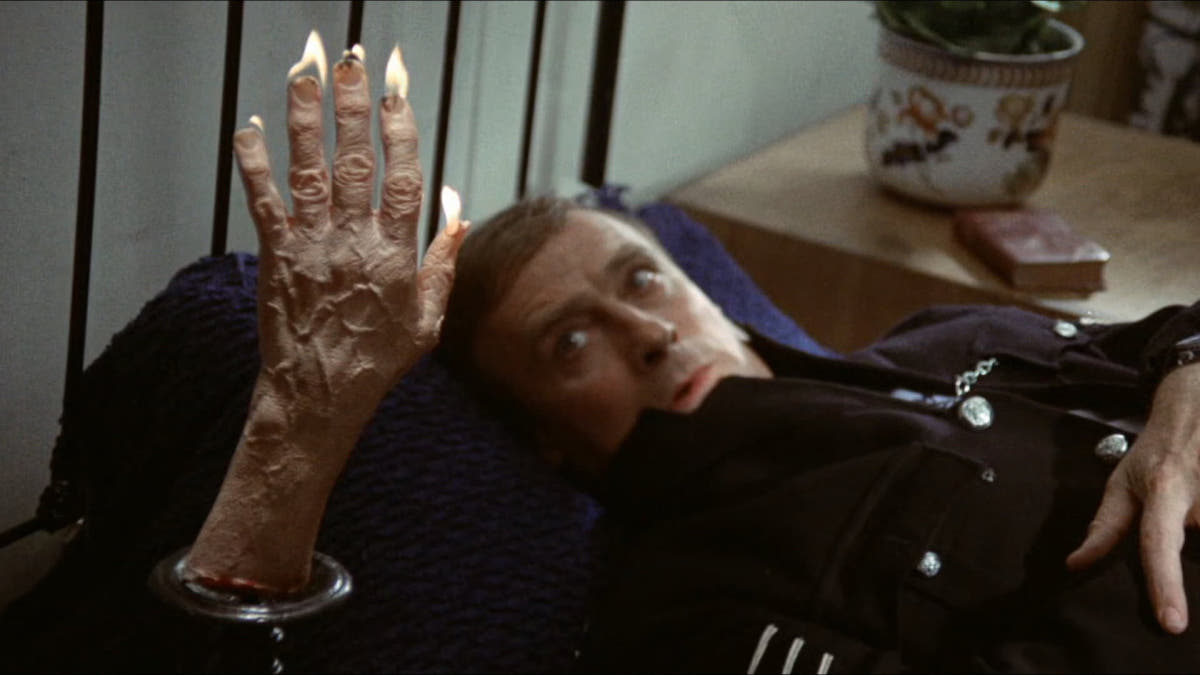
It’s significant that director Robin Hardy offers no other clues about Sgt Howie’s life beyond his uniform. We see him in church, but not at the police station. His home life is a mystery, and he arrives on the island solo. There’s no need for backstory here, as everything about him can be defined by who we see on the screen. Sgt Howie is a stone-faced rock about to drift further out to sea than he ever has before. No horror protagonist has ever felt quite so unequivocally alone.
Sgt Howie is rowed by a local man from the plane to the shore, where people peek out of windows to catch a glimpse of the new stranger in town. The buildings are all old and made of stone, crooked and sloping. It looks like many old villages across Britain do. Here, on this early Spring day, the sun is shining and on the soundtrack, ancient folk songs whisper about rigs of barley. But something is wrong, and the missing girl is only just the beginning. The smiles from the villagers and the songs they sing feel almost mocking—what right have they to be happy when a girl has vanished, and when Sgt Howie’s devoted his life to abstaining from pleasure.
In The Green Man inn, Howie’s patience is tested even further. After being told by locals that they don’t recognise the photo of Rowan (“She doesn’t belong to this island”), Howie is met by a ribald pub full of heavy drinkers, perpetually in the process of starting or finishing up another dirty folk song. “And when her name is mentioned, the pants of every gentlemen do stand up to attention,” they sing about the landlord’s daughter, Willow MacGregor (Britt Ekland). Howie sits like a ghost at the feast.
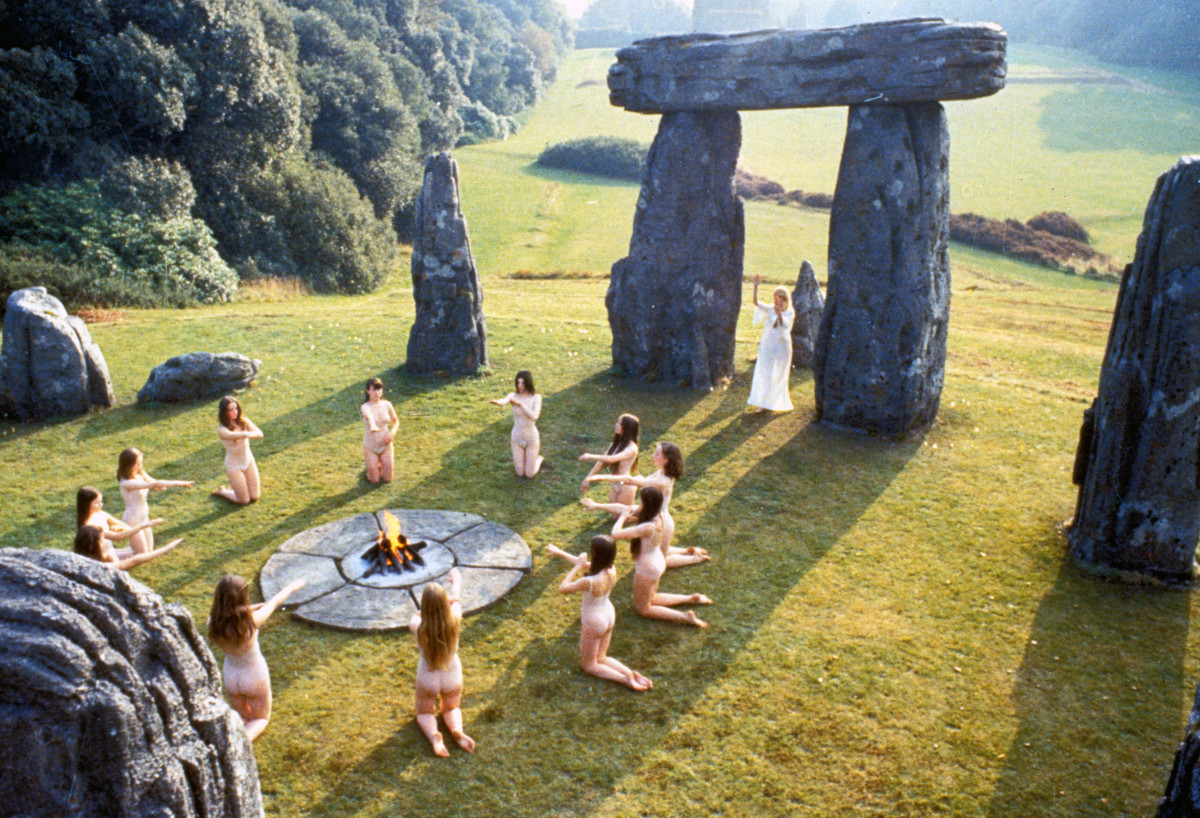
Robin Hardy, with a screenplay by Anthony Shaffer, makes Howie the odd one out. Everything he’s disgusted by is, essentially, innocuous. Silly pub songs, bright sunshine, and essentially happy people are what he’s up against. Does it all feel so sinister because we’re adopting his paranoia? Or is there a good reason to be so mistrustful? The series of interactions that provoke Howie have a darkly ironic humour to them, particularly as they become more and more outlandish. Outside the pub in the dark of night, a field of lovers writhe under the moon. Later, a group of nude women take turns leaping over a bonfire, surrounded by a Stonehenge-esque structure.
Hardy and Shaffer have a masterful grip on tone in these scenes. There is humour when Hardy cuts from the villagers to closeups of Woodward’s stony face, yet the underlying sense of foreboding is never quite yielded. Decades later, the nightmarish sitcom The League of Gentlemen (1999-2002) took great influence from The Wicker Man and blurred the line between horror and comedy even further. But the humour of The Wicker Man never feels like a relief—instead, it only serves to make things more macabre.
As Howie continues his investigation, he learns more about the town than he intends. In one squeamish scene, he walks in on May Morrison (Irene Sunter) placing a live frog in her daughter’s mouth to cure a sore throat. May is supposedly the mother of missing girl Rowan, but claims, after seeing a picture of her, that she’s not related to her. Her actual daughter, the one with the frog in her throat, isn’t even the same age as Rowan. At the local school, he hears a teacher (Ingrid Pitt) sermonising on the phallic nature of the maypole, which naturally appals Howie. He disrupts the class and finds not one of them has heard of Rowan. In an empty desk, which he believes belonged to her, he finds a beetle tied to a piece of wood, running in perpetual circles. Surely the symbolism isn’t lost on him.
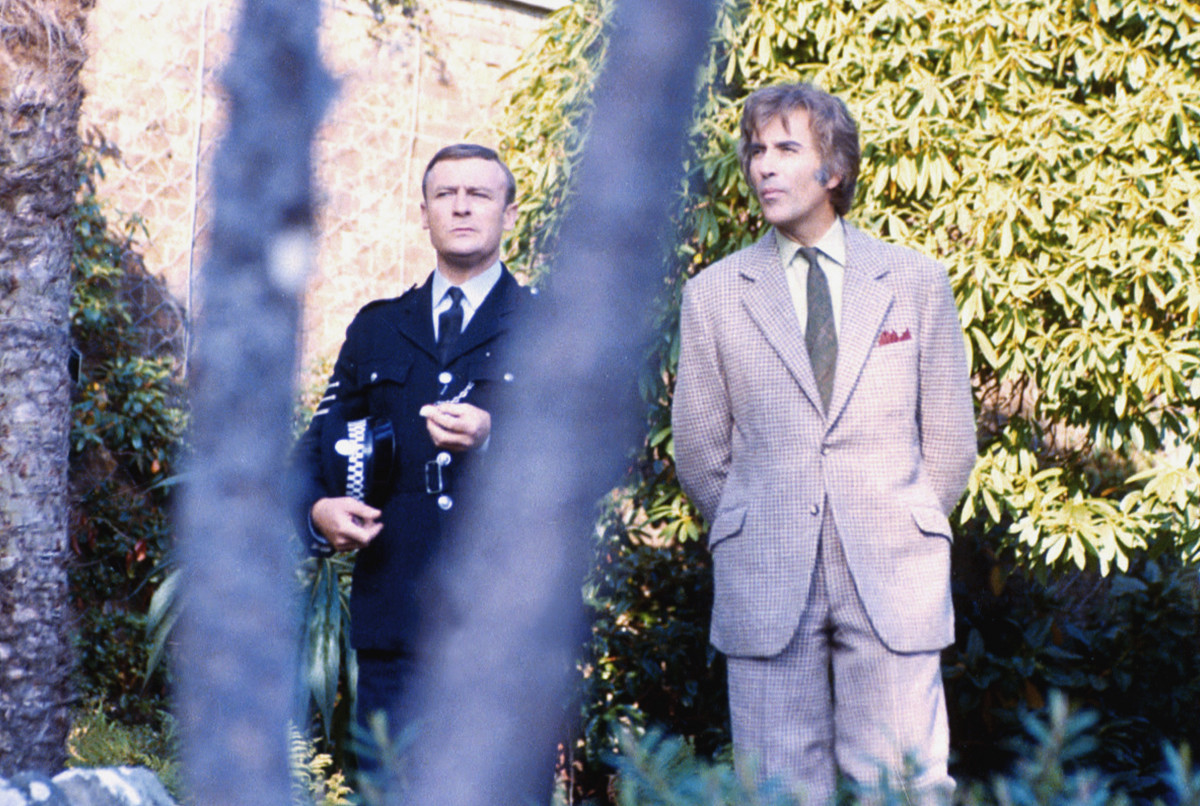
In an argument with the teacher, she succinctly encapsulates Howie’s greatest fear since he arrived in Summerisle. “I was unaware that the police had any authority in matters of education,” she says after he questions her choice of subjects. In education, in beliefs, and in the method with which these people live their lives, Howie has no authority. Everything that made him powerful and contributed to his sense of self is stripped away under the bright Hebridean sun. He’s but one man against many, and in his tirades the question is brought into sharp relief: does he want to arrest these people, or convert them?
The teacher finally acknowledges Rowan’s existence. “We do not use the word ‘dead’. People return to trees and air,” she claims. Such a Zen notion is met with disdain by Howie and his black-and-white thinking. It only fuels his thirst for answers, which he hopes he’ll attain from Lord Summerisle (Christopher Lee). He meets the leader of the town in his large country manor, and here, Lee perfectly manipulates our expectations. Though tall and imposing, and with a wild head of hair, Lee is the complete inverse of the characters he played in the decades previous. He’s charming and friendly, with just a hint of ex-hippie peacefulness.
His brief history of the island and its Pagan rituals sounds quite reasonable. He explains that the island’s biggest export is a strain of fruit his grandfather developed, aided by the specific climate of Summerisle. The rituals his grandfather employed were passed down from generation to generation, and so the townspeople now believe the practice of Paganism correlates to a good Harvest. This only angers Howie more, with him berating Lord Summerisle: “You’ve got fake biology, fake religion. Have you never heard of Jesus?” It’s a troubling sentiment, one echoed in conservative rhetoric today, emboldened by the belief that anyone who doesn’t believe what I believe must be insane.
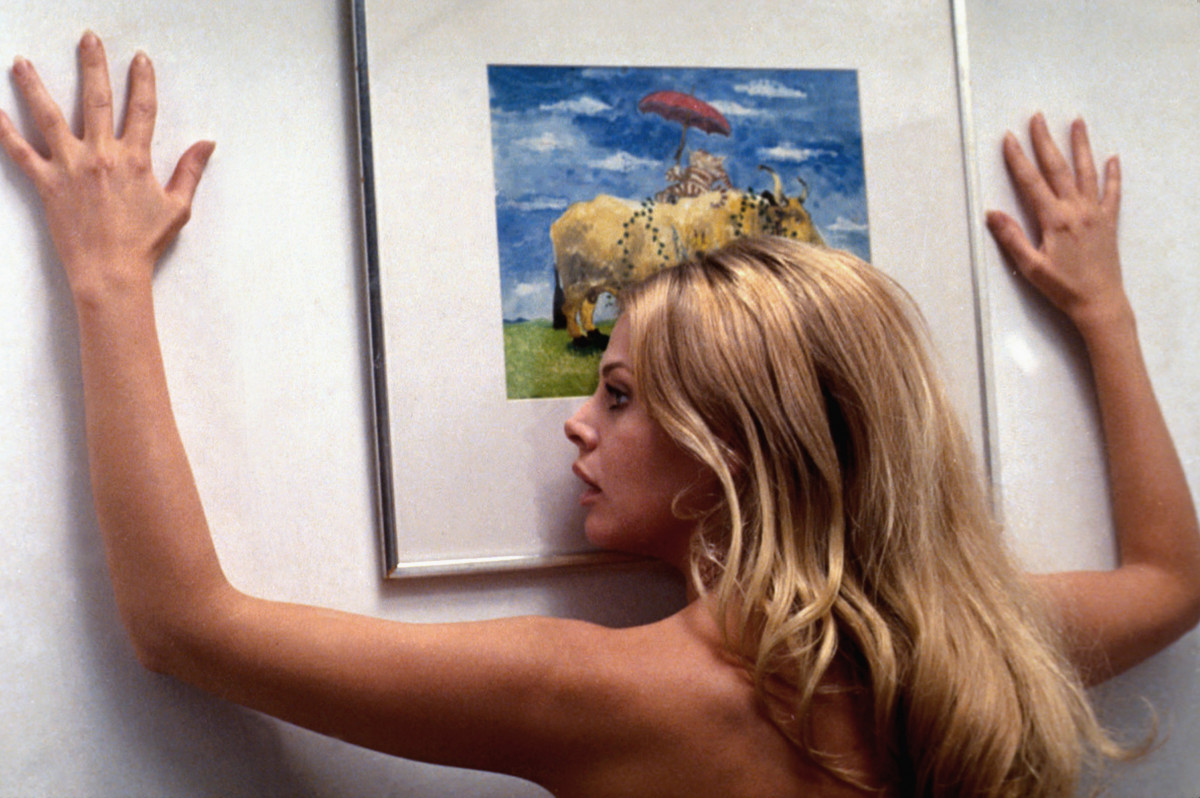
Shaffer’s screenplay gently suggests there may be more to Howie’s condemnation than it first appears. Back in his bed at the Green Mann, he hears the banging on the wall of the landlord’s daughter, Willow. In the adjoining room, she dances naked. Can Howie sense this? He sweats, twisting himself in knots as he tries to block out the sound. Here is his frustration at its most raw: temptation. He’s tempted by the beautiful woman next door, by the people making love in the fields, by people freer than he can fathom. He’s being seduced, a calf fattened for the slaughter.
Robin Hardy carefully selects a flashback sequence of Howie in a church, accepting the sacrament of wine and bread. Intriguingly, this takes on the same visual language as the Pagan rituals. Both are shot with a hazy gauze, twinned images that speak directly to each other in the film. It begs the question of whether there is a fundamental difference between the beliefs of Pagans and the beliefs of Christians. Both are filled with rituals and superstitions, but one operates on the fear and a desire for an afterlife, while the other is based on earthly pleasures in the here and now. It’s Howie who comes out looking hopelessly out of touch.
Like the naysayers of rock-and-roll in the 1960s, or the people who feared punk would corrupt the youth in the 1970s, Howie is a distinctly British type responding to a culture he can’t possibly understand. The battle is constantly fought in Britain, and that’s why the film still feels so transgressive, particularly as it suggests that Howie can’t only not win, but that his failure is secretly what we want to see. That doesn’t make the last half-hour easier to watch; it’s still one of the most terrifying passages in horror cinema.
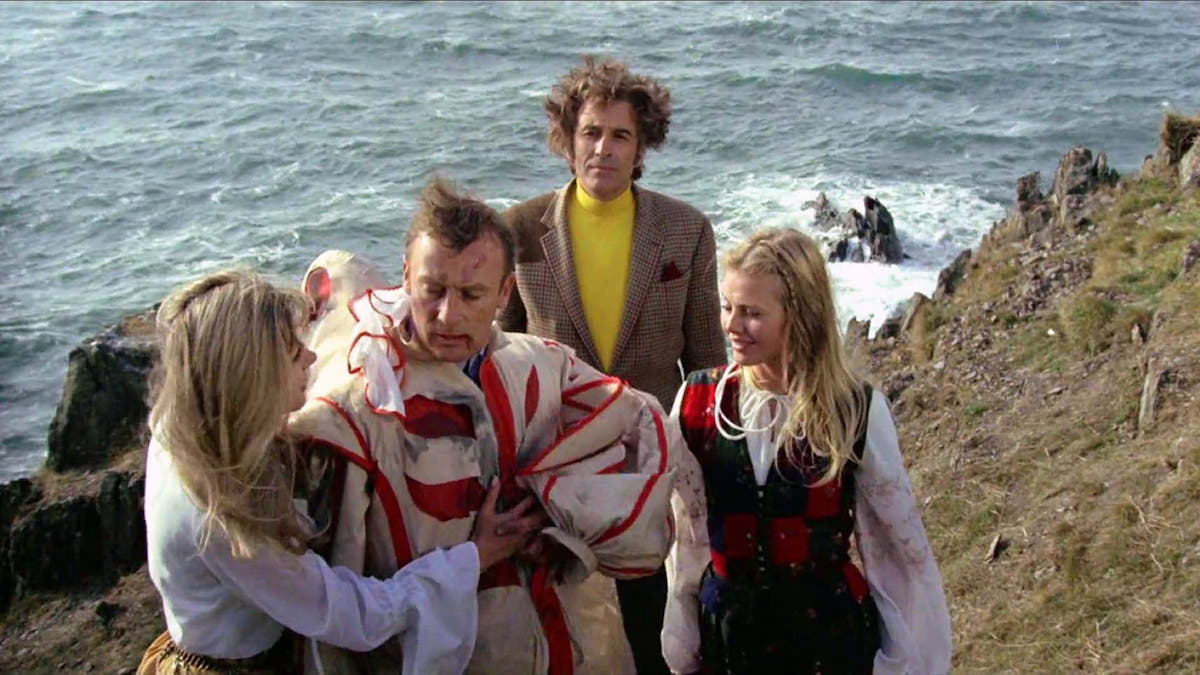
As the question of Rowan’s whereabouts leads Howie in circles, he begins to believe she’s alive and being kept hidden, to be used in a ritual sacrifice to ensure a good harvest. It’s on May Day, when the villagers wear animal masks and line the streets with dances and processions, that the town’s eccentricities begin to feel sinister. What is particularly distinctive about The Wicker Man‘s horrors is that not once do Hardy or Shaffer suggest any malice in the villagers. They aren’t aggressive, and as the inevitable march towards the effigy of a Wicker Man begins, they’re merely performing a ritual. To them, it’s not sinister or violent, it’s just a means to an end and their minds can’t be changed.
A final, agonising twist provides an ending that’s amongst the most wicked in the genre. Even after it ends, a disquiet still lingers, The Wicker Man having dredged up centuries worth of repressed and unspoken fears. The Wicker Man is seen as the quintessential British horror film, and the bedrock on which all folk horror was built. 50 years later, it still deserves that distinction. It’s a film that stripped a nation’s subconscious bare, using quaint and embedded British iconography to highlight the strangeness of our isles and the seeming incompatibility of our beliefs. It’s a battle of old and new, familiar and unfamiliar, with a final blow so grim that it could only have come from the 1970s.
From Kill List (2011) to Midsommar (2019), The Wicker Man‘s influence can be deeply felt in today’s horror landscape. But it stands, ultimately, alone—a truly singular and distinctive odyssey that invented and perfected a sub-genre in one fell swoop. To chase perfection in films seems futile, but it’s hard to think of a horror that comes as close to it as The Wicker Man. Half a century later, the siren song of Summerisle still calls out and is just as impossible to resist as ever.
Note: for this review, the 4K Ultra HD restoration of the Theatrical Cut was viewed.
UK | 1973 | 87 MINUTES (THEATRICAL) • 99 MINUTES (DIRECTOR’S CUT) • 92 MINUTES (THE FINAL CUT) | COLOUR | ENGLISH

StudioCanal have utterly outdone themselves with this release. This new 4K restoration of The Wicker Man is the best it’s ever looked, and is one of the finest restoration I’ve had the pleasure to see. Viewed on a 4K OLED television, the picture is remarkably crisp, with an array of new details to look out for. The colours are rich and deep, with the night time sequences having a new clarity to them which had been missing in past releases. The daytime scenes are sumptuous, and whenever fire is involved the restoration really begins to show off. It’s a revelatory viewing. The film’s soundtrack is an essential component, and the sound mastering here is excellent. Dialogue scenes are full and have a real depth, while the music sounds as if it was recorded yesterday.
The release contains a solid array of archival extras, which along with the newly commissioned pieces makes this the most comprehensive release of The Wicker Man as we’re ever likely to get. Even if you’re on the fence about the film, these discs are sure to sway you in its direction. An unmissable release.

director: Robin Hardy.
writer: Anthony Shaffer.
starring: Edward Woodward, Christopher Lee, Britt Ekland, Diane Cilento & Ingrid Pitt.
